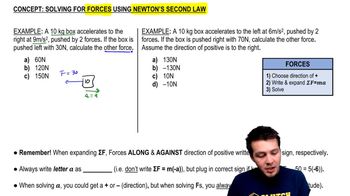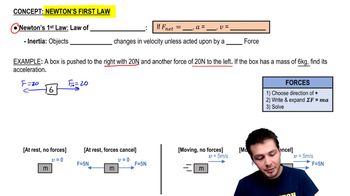6. Intro to Forces (Dynamics)
Newton's First & Second Laws
Learn with other creators
Practice this topic
- Multiple ChoiceA rock is in space, far from any planets, stars or black holes. It is moving in a straight line at a constant relative to our sun. What total force is required to keep it moving that fast?1468views
- Multiple ChoiceAn elevator is going up at a constant speed in a very tall building. Assume the only forces acting on the elevator are a downward weight force and the force of a cable pulling the elevator up. Ignore air resistance and friction. How does the magnitude of the weight force compare to the magnitude of the force of the cable?787views
- Multiple ChoiceA horizontal force is applied to a box causing it to speed up. The force of kinetic friction is . Which choice best describes the subsequent motion of the box?789views
- Textbook Question
A hockey puck with mass kg is at rest at the origin () on the horizontal, frictionless surface of the rink. At time a player applies a force of N to the puck, parallel to the -axis; she continues to apply this force until s. What are the position and speed of the puck at s?
1221views4rank - Textbook Question
A small -kg rocket burns fuel that exerts a time-varying upward force on the rocket (assume constant mass) as the rocket moves upward from the launch pad. This force obeys the equation . Measurements show that at , the force is N, and at the end of the first s, it is N. Find the constants and , including their SI units.
2459views - Textbook Question
A -kg experimental cart undergoes an acceleration in a straight line (the -axis). The graph in Fig. E shows this acceleration as a function of time. During what times is the net force on the cart a constant?
931views - Textbook Question
A -kg experimental cart undergoes an acceleration in a straight line (the -axis). The graph in Fig. E shows this acceleration as a function of time. Find the maximum net force on this cart. When does this maximum force occur?
2432views - Multiple Choice
Which of the following statements about dynamics is correct?
428views
















